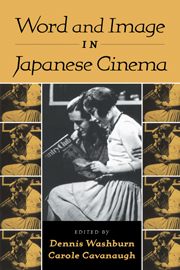Book contents
Foreword: Outside Views of the Japanese Film
Published online by Cambridge University Press: 01 March 2010
Summary
All Western views of the Japanese film are, by definition, outside. What I want to do is to put them in some sort of order and show how the methodologies have varied, how the focus has shifted, and how reflexive these outside views have proved.
Sergei Eisenstein, in a 1945 essay quoted by James Monaco, devised an analogy for film scholarship. First, there is the long shot, which sees in films political or social implications; second, there is the medium shot, which focuses on the human scale of the film; and finally there is the close-up, which breaks down film into its elements, attempts to treat it as a language, and so on. Whether Eisenstein intended these stages to be read chronologically or not, his paradigm has proved fairly accurate – certainly so far as Western scholarship on Japanese film is concerned.
All of this scholarship is postwar, and its beginnings are in the 1950s with the work of Marcel Guiglaris, of Joseph L. Anderson, and of myself. These first works were very much of their time. They were all in longshot, as it were.
Our methodology was also of its time. Both Anderson and I followed a main tradition of American criticism that was to see films not as products of authors, or of a structure approaching a language, but as evidence of social, cultural, and political movements. The model in our book was Lewis Jacobs: his work on the American cinema. Like him, we saw our field as culturally specific, yet our bias was toward synthesis rather than analysis, because we emphasized cultural values that Japan and America shared.
- Type
- Chapter
- Information
- Word and Image in Japanese Cinema , pp. xiii - xviiiPublisher: Cambridge University PressPrint publication year: 2000



